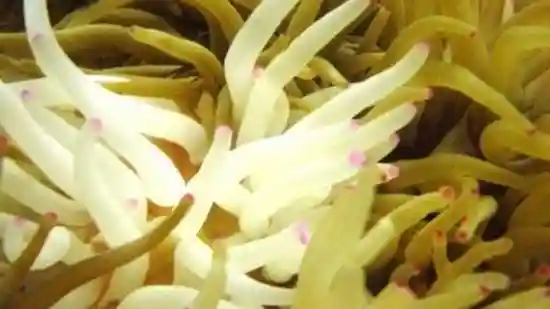Condylactis Anemone
Condylactis sp
(22 Reviews)

Condylactis Anemone
Condylactis sp
(22 Reviews)
{{ item.name }}
Size: {{ item.extra_field_3 }}
${{ getFormattedPrice(item.saleprice) }} ${{ getFormattedPrice(item.price) }}
To join the waiting list, click here
Free Shipping
With
$199.00
or more in Marine Life.
More details...
Condylactis Anemone Care Facts
| Care Level: | Easy |
|---|---|
| Temperament: | Semi-Aggressive |
| Diet: | Carnivore |
| Reef Safe: | Yes |
| Minimum Tank Size: | 50 Gallons |
| Max Size: | |
| Lighting: | High |
| Placement: | Any |
| Waterflow: | Moderate |
The Pink Tip Haitian requires strong light as well as live rock and several crustaceans. Although Haitian Reef Anemones requires a reef style environment, they are not ideally suited for the reef aquarium containing corals. Haitian Reef Anemones move around the tank and have a sting that can inflict grave damage to other anemones and corals. Unlike other anemones, the Haitian Reef Anemone does not have a relationship with any particular fish.
The Condylactis Anemone (Condylactis gigantea): A Graceful Beauty for Saltwater Aquariums
The Condylactis Anemone (Condylactis gigantea) is an interesting and elegant species of anemone that adds a touch of natural beauty to saltwater aquariums. With its striking appearance and intriguing behavior, this anemone species has become a sought-after choice among marine enthusiasts. Let's explore the Condylactis Anemone's habitat, reef-safe nature, size, lifespan, diet, aquaculture potential, stinging cells, symbiotic relationships, and compatible tank mates.
Habitat of the Condylactis Anemone
The Condylactis Anemone is commonly found in the tropical waters of the western Atlantic Ocean, ranging from the southeastern United States to the Caribbean and parts of the Gulf of Mexico. In the wild, they inhabit shallow reef areas with rocky substrates, attaching themselves and swaying with the ocean currents.
Reef-Safe Nature of the Condylactis Anemone
The Condylactis Anemone is generally considered reef-safe, as it typically does not harm corals or other invertebrates. However, it may engage in territorial behavior, so proper spacing should be considered to prevent conflicts with neighboring coral species.
Size and Lifespan of the Condylactis Anemone
Condylactis Anemones can vary in size, with some reaching diameters of up to 12 inches (30 cm) or more. They can have a lifespan of several years with proper care in a well-maintained aquarium.
Diet and Feeding Habits of the Condylactis Anemone
In their natural habitat, Condylactis Anemones are carnivorous, feeding on small fish, shrimp, and other small organisms that come into contact with their stinging tentacles. In a home aquarium, they can be fed a varied diet of meaty foods, such as frozen or live brine shrimp, mysis shrimp, and small pieces of fish or shrimp.
Aquaculture Options for the Condylactis Anemone
The Condylactis Anemone is available in the aquarium trade, but most specimens are collected from the wild rather than being captive-bred. Breeding and propagating this species in captivity can be challenging and are less common than with some other anemone species.
Stinging Cells and Defense Mechanism
Like all anemones, the Condylactis Anemone possesses specialized stinging cells called nematocysts. These cells are used for capturing prey and defending against potential threats. It is essential to handle them carefully to avoid stings, as some individuals may have more robust or potent stinging cells than others.
Symbiotic Relationships of the Condylactis Anemone
Condylactis Anemones do not have a symbiotic relationship with clownfish like some other anemone species. However, they provide shelter and protection to certain species of shrimp and crabs, forming a mutualistic relationship where both parties benefit.
Five Compatible Tank Mates for the Condylactis Anemone
- Peaceful gobies (e.g., watchman or neon gobies) for a dynamic and captivating display.
- Certain species of damselfish are compatible tank mates that add diversity and activity to the aquarium.
- Some species of pseudochromis can coexist with the anemone, adding color and personality to the tank.
- Peaceful hawkfish species can be compatible tank mates for the Condylactis Anemone.
- Certain tang species are suitable tank mates that bring graceful movement and elegance to the aquarium.
In conclusion, the Condylactis Anemone (Condylactis gigantea) is a graceful and captivating addition to saltwater aquariums. Its unique appearance and compatibility with certain tank mates make it popular among marine enthusiasts. Aquarists can enjoy the beauty and allure of these enchanting anemones by providing them with a suitable environment, compatible tank mates, and proper care.
Exc
Reviewed by: Maria Robles on Aug. 24, 2025
Reviewed by: Jason Jenkins on June 29, 2025
Beautiful anemone
Reviewed by: Maria Robles on Jan. 27, 2025
Reviewed by: Rob Lorence on Dec. 22, 2024
Reviewed by: Shawn Dickerson on Dec. 12, 2024
Easy care, very eye appealing, very hardy and cheap...tried the other more expensive ones...this one (bought 4 so far) far less hassle and they stay put a lot better than the other guys in the past...I wave at them and they wave back...what's for lunch mom? We like your marine pellet food
Reviewed by: Bridget on Nov. 14, 2024
Beautiful & robust!!!
Reviewed by: Bridget Meyers on Nov. 12, 2024
Very nice, I want more...
Reviewed by: Bridget Meyers on Oct. 28, 2024
Reviewed by: Javier Gonzalez on Oct. 28, 2024
Received yesterday, bought 2, these guys are great...picked their own spot and very happy...not moving around the tank like other anemones I've owned...fish don't pay any attention to them which is good...just going with the flow gently swaying around...like their new home as it appears...very happy with purchase
Reviewed by: Bridget Meyers on Oct. 23, 2024
Very full beautiful
Reviewed by: Ricky Hardee on Aug. 21, 2024
Reviewed by: Gary Sparks on June 9, 2024
Beautiful Anemone
Reviewed by: Maria Robles on June 4, 2024
Reviewed by: Debbie Konechney on Feb. 7, 2024
These anemones are awesome. Thankfully they found their spot right away. They have hiding spots and only want a little light. I first thought they liked moderate to high lightning. Turns out they are opposite. They like low light and enjoy hiding. They will also tell you when they want their meaty snacks. They are very aggressive when you bring their food to them. They will snatch it quick. I’m very happy with these anemones!
Reviewed by: Dale Pichelmayer on Jan. 29, 2024
Unbelievably hardy anemone it went straight to regular every day life the second it was introduced to its tank.
Reviewed by: Sean Boyer on Jan. 23, 2024
I’ve always seen these at Petco and they looked good. So I gave my business to saltwaterfish.com and purchased 2 of them. If you’re into anemones and already have them established, pick up one or more of these and you’ll entire tank will have tentacles swaying.
Reviewed by: Dale Pichelmayer on Jan. 17, 2024
Reviewed by: David Pavlicek on Jan. 16, 2024
Large and healthy but really no color on the tips. Very good value for an anemone.
Reviewed by: Colin Devine on Jan. 1, 2024
Reviewed by: Leticia Camacho on Dec. 13, 2023
Reviewed by: Erin Holmes on Dec. 11, 2023
Awesome , one has adapted well however the other is still getting adjusted not opening up.
Reviewed by: Anthony Mitchell on Sept. 4, 2023







